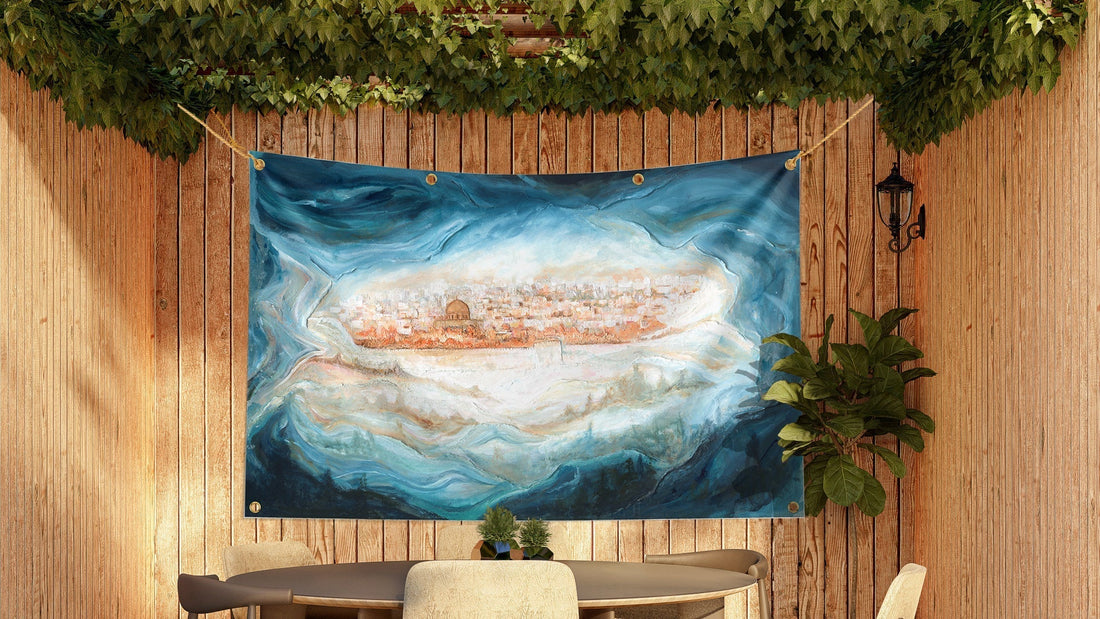
Sukkah Decor Halacha: From Muktzeh Foam Chains to Printed Kiddush
Share
Sukkot is one of those holidays where the lines between tradition, creativity, and halacha blur in the most delightful ways. You’ve got palm fronds on roofs, meals under the stars, the most perfect Sukkah mural and, in some cases, decorations that take on a life of their own – like 850-link foam chains weaving around doorways and sneaking beyond the Sukkah walls.
With all that seasonal sparkle, it’s no wonder people start wondering: My Sukkah mural isn't quite hanging straight – can I touch that decoration? What if it hangs outside the Sukkah? Can I read Kiddush straight off the wall if it’s printed on canvas?
Let’s unravel these questions, and maybe a foam chain or two, in a deep-dive into some surprisingly nuanced Sukkah decoration scenarios.
The Curious Case of the Wandering Foam Chain
Imagine this: over the years, you’ve created a festive chain out of foam links for your Sukkah. It’s become a bit of a tradition, and now it’s massive – spanning several meters and stretching beyond the Sukkah, looping around the house before returning to zigzag inside. It’s whimsical, it’s impressive... and it’s raised some halachic eyebrows.
Specifically, can you touch that Sukkah decoration over the intermediate days of the holiday, Chol HaMoed?
Here’s where it gets interesting.
Muktzeh: Not Just a Fancy Word
In halachic terms, muktzeh refers to objects that are off-limits for handling on Shabbat or Yom Tov – things that don’t have a permitted function during those sacred times. Think phones, wallets, or even that foam chain if it’s designated as a Sukkah decoration.
Sukkah decorations fall under this category because they’re considered part of the mitzvah. Once you hang them up, you’ve essentially declared: “These are for Sukkot use only.” So even if they dangle halfway to the mailbox, you shouldn’t move them – unless you planned ahead.
The Power of the Tnai: Your Halachic Loophole
That’s where the tnai – a pre-holiday condition – comes in.
Before the holiday begins, you can make a verbal (or even mental) declaration stating that you don’t intend for your decorations to become muktzeh. That way, if the chain slips, twists, or ends up blocking the front door, you can move it without violating halacha. Without a tnai, the decoration is effectively frozen in place for the duration of the festival.
And yes, this applies even to parts of the decoration that extend beyond the Sukkah’s physical structure. Once something is designated as a Sukkah ornament, it doesn’t stop being sacred just because it’s hanging over the neighbor’s dog.
Reading Kiddush Off the Sukkah Wall: Permissible or Problematic?
Let’s switch gears.
You’ve got one of those ready-made Sukkah Kits, perhaps even the kind that can come printed with the Kiddush text. Convenient, right? No need to fumble for your bencher under the table. But a question arises: Are you allowed to read Kiddush directly from the wall?
At first glance, it seems harmless. After all, you’re not tearing anything down or leaning on the Sukkah. But halachically, there’s a principle that one should not derive benefit from the Sukkah itself – its walls or Schach (roof covering). Could reading sacred text printed on the wall qualify as using the Sukkah for personal gain?
Let’s break this down.
When Is a Wall Not Just a Wall?
The comparison often brought up is to Chanukah candles, which the Talmud says we can’t use for light – reading by them is considered benefiting from a mitzvah object, and that’s a no-go.
But Sukkot has its own logic. In this case, the wall isn’t serving some unrelated function – it’s helping you perform the very mitzvah the Sukkah is designed for. Making Kiddush inside the Sukkah is not just allowed – it’s the ideal. So reading Kiddush off the wall isn’t using the wall for something separate; it’s part of the mitzvah experience.
Some authorities also point to a broader principle: mitzvot weren’t given for personal enjoyment (mitzvot lav lehanot nitnu). If you incidentally benefit while doing a mitzvah – say, enjoying the shade or reading Kiddush – it’s not considered “pleasure” in the prohibited sense. It’s part and parcel of doing the mitzvah.
But What About the Wall’s Status?
Even with that leniency in mind, the halacha does distinguish between different parts of the Sukkah. According to the Shulchan Aruch, unless you made a tnai, the walls themselves may be off-limits for benefit throughout the festival.
However, commentaries like the Beiur Halacha suggest that if you took a break after building three walls and only later put up the fourth, it might be permissible to make a tnai on that last wall specifically. So depending on how you constructed your Sukkah – and whether you made any conditional declarations – you may be able to read Kiddush off that wall guilt-free.
Final Thoughts: When Foam Meets Halacha
Sukkot has always been a blend of structure and spontaneity – ritual and decoration, ancient laws and modern creativity. Whether you're looping foam chains out your window or reading blessings off your wall, the beauty lies in the details.
Just remember: when in doubt, make a tnai. It might not solve every halachic dilemma, but it’ll make your holiday a lot more flexible – and festive.
And if all else fails? Ask your local rabbi. Preferably before stringing decorations across the neighborhood.
